Posts by Christopher Lochhead
118 Why Are We Yelling w/ Buster Benson

Podcast: Play in new window | Download (Duration: 52:31 — 72.1MB) | Embed
Subscribe: Apple Podcasts | Spotify | Pandora | RSS | More
In this episode, we continue our run of legendary authors as we feature Buster Benson and his new book, “Why are we yelling?: A fascinating look at why and who we argue.” Buster shares with us the inspiration of his book, the constant-learning that he is having and how it can be applied to work and life, in general.
Agree to Disagree
Buster candidly shared with Christopher that of all the hard topics he decided to take on, it was the topic about disagreements that he deemed to be one of the hardest. He still pursued this topic as he was challenged to tackle this topic. He also admits that the inspiration for the book was his curiosity on cognitive bias.
“That is the initial problem. in order to have a conversation about disagreement, we have to be open to the idea that we don’t have the right answer.” – Buster Benson
Birds and Biases
Buster shares that cognitive bias is an evolutionary term. It is a threat that could potentially lower our survival. It has the connotation that if we’re wrong, we would want to avoid it. In modern society, being wrong leads to being ousted from a certain group.
To illustrate this, Buster shared the habits of birds looking for a nesting ground. These birds fight off other birds and other animals to have authority over a tree. In real life, human beings as a bird, are not going to engage other “birds” in civil disagreement.
“You’re going to just try to be the bigger bird and force the other one out. When we’re no longer in a situation and there’s only one tree and we have to have a nest here, or else we’re gonna die, we ask, is this tree big enough for multiple birds?” – Buster Benson
Growth is the Consequence
The consequence of being wrong is actually growth. Further, Buster shares that if we are good at several skills, it makes us more skilled at everything else. For example: talking, being literate, being able to self reflect magnifies the value of other skills. He introduces the importance of productive disagreement as well in this episode.
“‘How do I treat somebody that is normally a threat to my survival, as an opportunity for growth’ is the core cognitive dissonance in disagreement.” – Buster Benson
To hear more about the author of “Why are we yelling?” Buster Benson, download and listen to the episode.
Bio:
Buster Benson wrote the book titled “Why Are We Yelling? The Art of Productive Disagreement”. He also run 750words.com with my wife.
His interests include creative businesses, collaborative disagreements, cognitive biases, enterprise software, messaging platforms, behavior change, social games, silly drawings, making life a little bit better through technology.
Read more about his through this link.
Links:
We hope you enjoyed this episode of Follow Your Different™! Christopher loves hearing from his listeners. Feel free to email him, connect on Facebook, Twitter, Instagram and subscribe on iTunes! Get amazing, different stories on business, marketing, and life. Subscribe to our newsletter The Difference.
117 What School Could Be w/ Ted Dintersmith
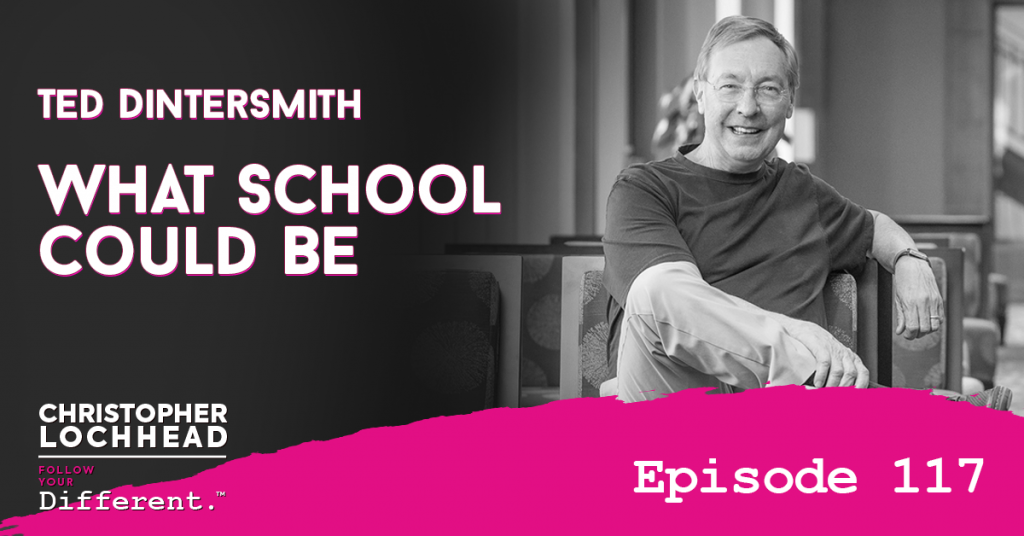
Podcast: Play in new window | Download (Duration: 1:24:45 — 116.4MB) | Embed
Subscribe: Apple Podcasts | Spotify | Pandora | RSS | More
We continue our run of legendary VCs and legendary authors like our guest for today, Ted Dintersmith. He’s a former top tech VC and he’s the author of the book What School Could Be: Insights and Inspiration from Teachers Across America. This is a powerful look at what’s possible in education from a smart, committed, super thoughtful guy.What School Could Be
Ted Dintersmith went to all fifty states, visiting some 200 schools and spoke to different school personnel and students. He says he was stunned by the innovative classrooms and schools he found across the USA. However, he also talked about schools who he described as good in paper, but not as good in reality.“There were so many schools like that, where on paper, it looks likes the kids are doing really well. Good grades, good test scores, reasonable to good College placements. The point I make is that I think these kids, are not really being helped in terms of being prepared for a world defined and shaped by innovation. They’re actually being impaired.” – Ted Dintersmith
Shifting Mindsets
Ted shares his conversations with school teachers, administrators and students shifted his thinking. He further says that the measure of success in so many schools is aligned with a few narrow capabilities. He questioned the schools, asking if he puts a kid in their school who excelled at memorizing material, replicating low-level procedures and following instructions, he bets that kid would be on the honor roll.“SAT tutors say, ‘don’t be creative when you take this test. Don’t think of unusual ways to answer it. Think clearly, simply and formulaically. The 2nd thing is, if it’s hard and it’s going to take a while to figure it out, skip it.’ Is that a great message for the kids?” – Ted Dintersmith
Education is a Pie Eating Contest
Ted continues to share with Christopher his insights that many kids are being told that they’re not gifted because they don’t match up to those narrow skills. Christopher also remarked in an overly simplistic form, that education nowadays is like a “Pie Eating Content” where you jam everything, regardless of what kind of pie it is, and know that the more you take, the better.“It’s crazy. We organize most of education around what’s easy to test and not what’s important to learn.” – Ted DintersmithTo hear more about how to encourage kids, unleash their passion and support dedicated teachers and more about Ted Dintersmith, download and listen to the episode.
Bio:
About TedLinks:
Ted Dintersmith Twitter: @dintersmith We hope you enjoyed this episode of Follow Your Different™! Christopher loves hearing from his listeners. Feel free to email him, connect on Facebook, Twitter, Instagram and subscribe on iTunes! Get amazing, different stories on business, marketing, and life. Subscribe to our newsletter The Difference.116 Dreamforce Special w/ Salesforce’s Vala Afshar
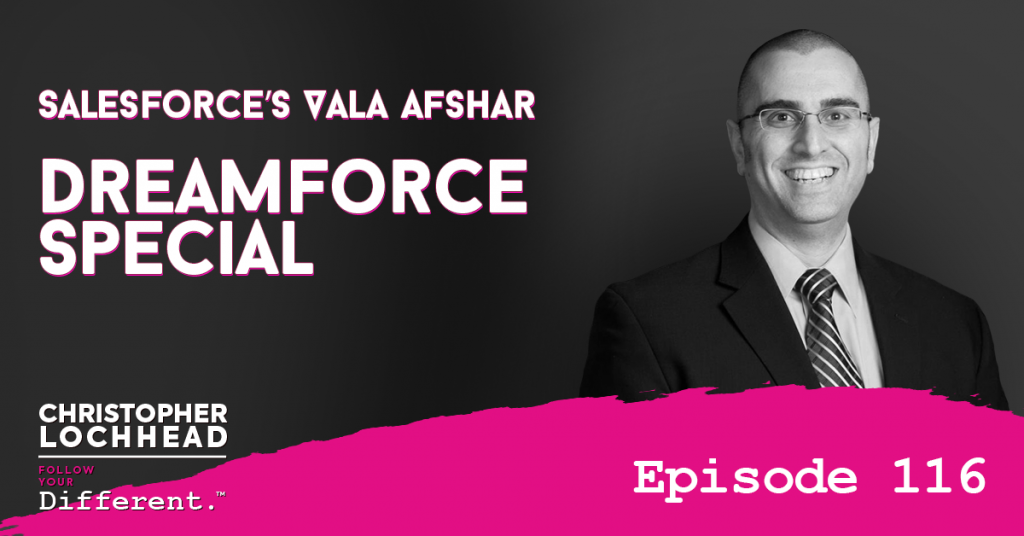
Podcast: Play in new window | Download (Duration: 35:57 — 49.7MB) | Embed
Subscribe: Apple Podcasts | Spotify | Pandora | RSS | More
This special episode is with Chief Digital Evangelist at Salesforce.com Vala Afshar. Coinciding with Dreamforce —Salesforce.com’s annual mega-conference in San Francisco, Vala shares with us what it’s like to be a leader in the digital media age.
He also shares some of the key practices that have made Salesforce #1 on Forbes most innovative companies list.
Social Business Excellence
Vala is the author of The Pursuit of Social Business Excellence. He is also the co-host of DisrupTV and one of the most visible and impactful thought leaders in enterprise tech. On the side, he is a contributing writer at HuffPost, which he claims were one of his ticket for his CMO career.
“I was a CMO for 4 years. Complete impostor syndrome from beginning to end because I never had Marketing experience, I never went to school to study the art and science of Marketing. My CEO called me on a weekend saying ‘on Monday I’m gonna announce that you’re going to be the CMO.” – Vala Afshar
He narrates to Christopher how the energy and confidence that he used to have as an athlete, did not translate to who he has become as a business person. However, he got through this challenge as he had the passion to share information.
From An Introvert to a Keynote Speaker
For an introvert, Vala narrates how he spent 10 years writing codes. He was perfectly happy locked up in a cube, just writing software. He is still amazed with how he opened himself up to people and to be able to share the stage with Christopher in various events.
“Movement is the ultimate status symbol. Movement of information. Again, in my first 40 years, if I read a book or listened to your podcast, I would just consume it and then that’s it, it stayed with me. In the last 5 or 6 years, when I learned something, I try to capture that and share.” – Vala Afshar
Salesforce Innovation
Vala quotes other professionals on why they think Salesforce is successful: it’s because of technology disruption. This disruption is in terms of ‘how do you build an ecosystem, how do you give away your time, money and profit, how do you build a company based on emerging technology and how do you create new business models.
“The 111 Philanthropic model was pretty unique and now about 10,000 companies have adopted that. The subscription model, pay as you go, that’s like the envy of most business..” – Vala Afshar
He also shares about the Salesforce module called V2mom, a mobile compatible app where employees align with the company vision, values, methods, obstacles, and measurements.
To hear more about the best practices of Salesforce.com and leadership advice from Vala Afshar, download and listen to the episode.
Bio:
Vala Afshar is the Chief Digital Evangelist for Salesforce.
Afshar is the author of The Pursuit of Social Business Excellence. Afshar is also the co-host of DisrupTV, a weekly show covering the latest digital business and innovation market trends.
Links:
HuffPost Contributor: Vala Afshar
We hope you enjoyed this episode of Follow Your Different™! Christopher loves hearing from his listeners. Feel free to email him, connect on Facebook, Twitter, Instagram and subscribe on iTunes! Get amazing, different stories on business, marketing, and life. Subscribe to our newsletter The Difference.
115 Heidi Roizen Silicon Valley Legend
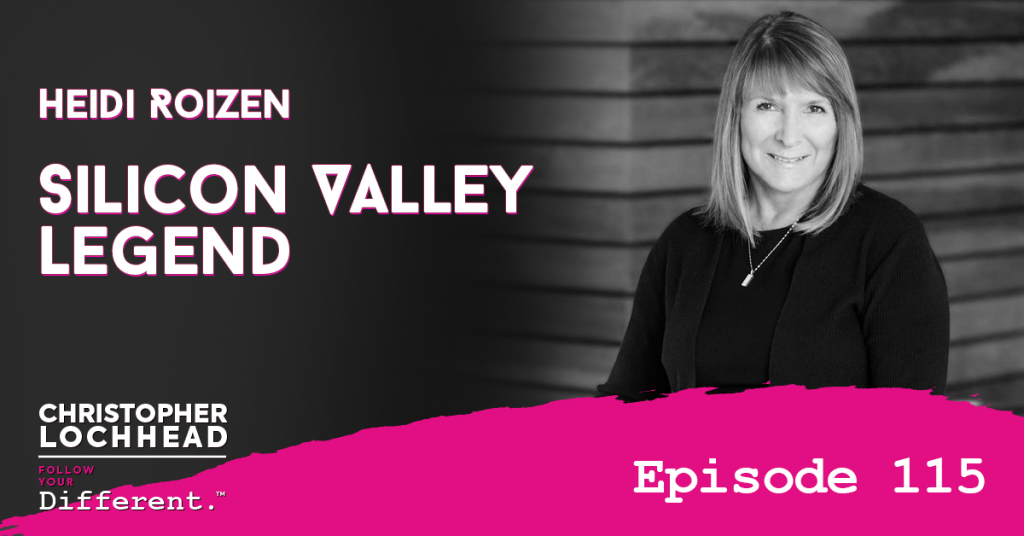
Podcast: Play in new window | Download (Duration: 1:06:50 — 93.1MB) | Embed
Subscribe: Apple Podcasts | Spotify | Pandora | RSS | More
Today’s guest is none other than Silicon Valley Legend, Heidi Roizen. She is an accomplished, Entrepreneur, former head of developer relations at Apple and now, a legendary VC. She shares with us why today is the Golden Era for entrepreneurship, how any company is literally a tech company and more about VC-backed company, Memphis Meats.
Silicon Valley’s Greatest Connector
The Financial Women of San Francisco honored Heidi as Financial Woman of the Year in 2018. She is also dubbed as “Silicon Valley’s Greatest Connector.” She is currently sits on the board of companies such as Zoox, Planet, Memphis Meats, HelixRE and DMGT.
“I talk about the fact that there should be more women entrepreneurs and there should be more women venture capitalists and diversity. Not just gender diversity but other diversity and I try to support that through my actions. I think it’s appropriate given my role in Silicon Valley. If I have an opinion about that, I should be vocal about that.” – Heidi Roizen
Other than these achievements, Heidi is a self-proclaimed animal lover. She adopted several dogs from the shelter, which she fondly shares in her social media.
Golden Era of Entrepreneurship
Heidi describes the market as a seller’s market when it comes to early-stage equity. There are a lot of sources of capital in the market, its very competitive. She enumerates all the positive assets entrepreneurs have in today’s world.
“There’s just so many different avenues for funding. There are so many tech breakthroughs that can be built upon, whether that is networking or processing power, sensors, devices, GPS, next-gen VR technologies, ubiquitous platforms. When you think about the kinds of businesses you can start today for pennies, which costs hundreds of thousands of dollars in the past.” – Heidi Roizen
The only negative she can mention is about competition, as she believes everyone else can also solve many big, interesting problems. Additionally, she mentions why companies nowadays are considered tech companies.
“I do think it’s interesting today is, every company is a technology company, right? For the most part, how they interact with the customers, how they distribute their products, how they garner feedback, how they handle customer service, tech support, logistics, supply chain, internally, HR systems—every company is deep in technology now.” – Heidi Roizen
Memphis Meats. Cell-based Meat
Heidi shares more about Memphis Meats and why she believes there is a huge growth potential for cell-based meat. First, she discusses how meat is inefficient to produce: from breeding to feeding to slaughtering and distribution to markets. Not only does it requires more resources, such as land and water use, it is also highly prone to contamination.
“The great thing about being a venture capitalist is, we don’t have to actually invent this stuff. There are really awesome entrepreneurs that are way smarter than we are who come up with these ideas. We just have to make sure they want to come to talk to us, and that we can validate sufficiently what they are doing through our own research learning.” – Heidi Roizen
To hear more about legendary Silicon Valley stories of Heidi Roizen, download and listen to the episode.
Bio:
Heidi represents the voice of the entrepreneur, having been one herself.
But she also represents the voice of the user, as those are the roots that led her to start a company in the first place.
She is on the boards of directors of Zoox, Planet, Memphis Meats, HelixRE and DMGT (LSE:DMGT.)
After Heidi earned her undergraduate and MBA degrees from Stanford, she co-founded T/Maker, where she served as CEO for over a decade through its acquisition by Deluxe Corporate in 1994. Next, she joined Apple as VP of Worldwide Developer Relations, and from there, Mobius Venture Capital.
She’s been named to the Corporate Board Member’s “Top 50 Women in Tech” list and Hot Topics’ Top 100 Women in Tech.
In 2018, Heidi was named the Financial Woman of the Year by the Financial Women of San Francisco.
She has also earned the Forum for Women Entrepreneurs and Executives Annual Achievement Award, among other accolades.
Heidi currently holds two leadership positions at Stanford University.
She co-leads the Threshold Venture Fellows in the Management Science and Engineering department at Stanford. She is also a member of the advisory council of Stanford’s Institute for Human-Centered Artificial Intelligence.
Links:
Silicon Valley’s Greatest Connector
Financial Women of San Francisco Name Heidi Roizen 2018 Financial Woman of the Year
We hope you enjoyed this episode of Follow Your Different™! Christopher loves hearing from his listeners. Feel free to email him, connect on Facebook, Twitter, Instagram and subscribe on iTunes! Get amazing, different stories on business, marketing, and life. Subscribe to our newsletter The Difference.
114 Think Like Amazon w/ John Rossman
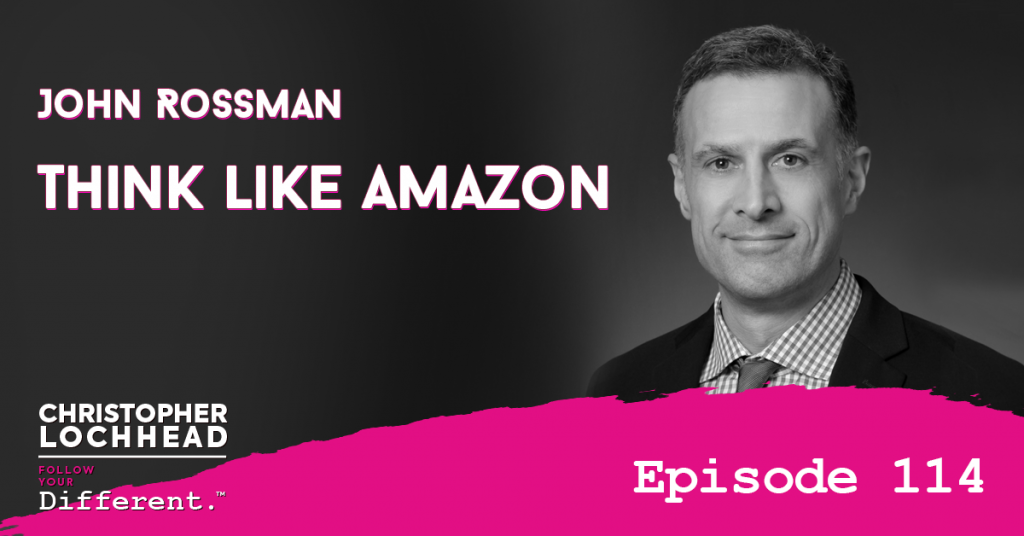
Podcast: Play in new window | Download (Duration: 56:44 — 78.2MB) | Embed
Subscribe: Apple Podcasts | Spotify | Pandora | RSS | More
For the second part of our two-part series on legendary category king companies, we are featuring John Rossman, author of “Think Like Amazon.”
We have a fun, insightful conversation about how Amazon became arguably the most innovative category king in the world and most importantly, how you can learn to think like Amazon in your career.
Digital vs. Traditional
Christopher probes John on his thoughts about the distinction between traditional businesses versus data-driven, digital ones. John shares that other than the technological aspect, he could relate digital businesses to athletic attributes such as speed and agility.
In detail, John said speed is about doing a repetitive motion, extremely well and efficiently. In business terms, that is considered as operational excellence. The second attribute, agility, is the ability to sense and make change happen.
“Part of being digital is about the eternal pursuit of becoming perfect. How do we reduce cycle times? Improve quality, reduce costs? Cut out little pieces of friction from both our customers and employees?” – John Rossman
Embracing New Niches
John cites Amazon’s business strategy in terms of embracing new niches. The other aspect of finding problems, then working on a solution, is the notion of working into the future. He defines the future as a “time and a place for unconstrained thinking.”
“Amazon’s answer to that, their philosophy or their technique is: start with the customer and work backward. ” – John Rossman
When teams are brainstorming, all of these constraints come to the table and they deliberately understand which parts of the solution they are. Afterward, they identify the right mindset, then the right tools and ultimately, the right approach in order to solve the problem.
Architecture is the Business Strategy
Citing some parts of the book, Think Like Amazon, Christopher asks John the idea behind the concept architecture is the business strategy.
“You have to plan forward on how you build things, because the constraints, the flexibility the adaptability on how you build your operations and your technology architecture—will either be a key enabler or key constraint in your ability in going forward.” – John Rossman
In the end, John shares that his whole goal is to give a business person, who is not technology architect, a set of tools and questions that they utilize to be a better partner with their technology expert
To hear more about how digital businesses like Amazon innovate across entire the entire value-chain and John Rossman’s thoughts on how to make wise bets on new business ideas, download and listen to the episode.
Bio:
John Rossman, Digital and Innovation Advisor
Mr. Rossman is an expert at digital business models, operations and organizing programs. He has led engagements on developing innovation processes, Internet of Things strategies, marketplace and API driven platform business models.
He is a sought after speaker on creating a culture of operational excellence and innovation.
Mr. Rossman has worked with clients across various industries, including retail, insurance, education, healthcare, consumer products, industrial products and transportation.
Mr. Rossman’s notable assignments include The Bill and Melinda Gates Foundation, Microsoft, Nordstrom and several of the world’s leading retail and insurance organizations.
Prior to Rossman Partners, John was a Managing Director at Alvarez and Marsal, a performance improvement consulting firm.
Prior to A&M, John was an executive at Amazon.com where he launched the Marketplace business and third party selling platform, and ran the merchant services business.
Links:
We hope you enjoyed this episode of Follow Your Different™! Christopher loves hearing from his listeners. Feel free to email him, connect on Facebook, Twitter, Instagram and subscribe on iTunes! Get amazing, different stories on business, marketing, and life. Subscribe to our newsletter The Difference.
023 Trendjacking Marketing and Public Relations w/ Paul Maher
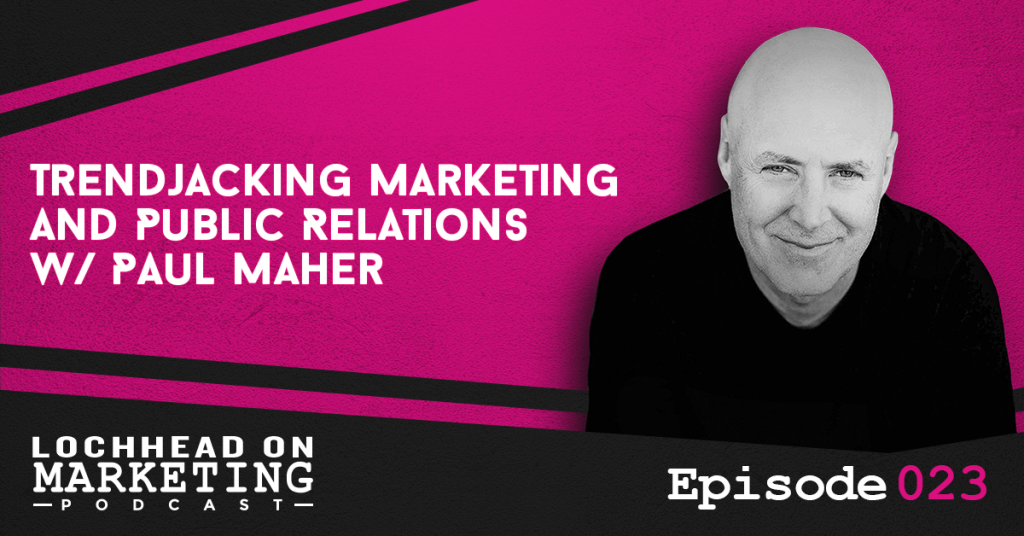
Podcast (lochheadonmarketing): Play in new window | Download (Duration: 27:54 — 38.5MB) | Embed
Subscribe: Apple Podcasts | Spotify | RSS | More
Today is another special episode of Lochhead on Marketing as Paul Maher, Founder of Positive Marketing (UK) joins us to talk about Trendjacking Marketing and Public Relations. His firm, Positive, won the SABRE Award for Best-earned Media Agency in Europe, Middle East, and Africa.Trendjacking
Paul Maher discusses the secret black art of marketing, PR, communications, and media called the trendjacking. This PR strategy is widely used nowadays as marketers aim to position themselves to become consistently relevant to their market.“Trendjacking is all about how do we take what’s happening in the news and attach ourselves to that, use that as an advantage to become an expert, to become known, to position ourselves effectively.” – Paul MaherChristopher and Paul have worked in several projects in the past and have actually the promulgators of trendjacking when they diverted a mergers and acquisition news of a competitor in the past.
Seven Secrets of Trendjacking
1. BE POSITIVE The news happens anyway, why not be in it? Category leaders make rather than observe the news. 2. BE PROVOCATIVE To do this you need to recognize the very definition of news is what you DIDN’T know, or as William Randolph Hearst, the biggest news baron of the pre-Facebook world famously said, ‘WHAT SOMEONE ELSE DOES NOT WANT YOU TO KNOW’. Get creative and find out who does not want to know what you want to say. 3. PREDICT (IT’S CALLED A NEWS CYCLE FOR A REASON) As well as great content, you need great timing. To know when is the optimal time to drop your bomb, you need to read patterns and become a news junkie, not an expert on everything from Celebrity Diets to Robot Brain Surgery, but at least stay across what’s going on in your sector. Preferably twice or more a day. Alternatively hire help, in the form of an agency or consultant who will. 4. PREPARE, PREPARE, PREPARE Set the trap and give yourself options. So perhaps have a set of pitches for each eventuality. England’s new Prime Minister Boris Johnston, also until recently one of the UK’s highest-paid newspaper columnists wrote two versions of an opinion piece, one for and one against Brexit. This way he hedged his bets and prevented a last-minute rewrite, we do this often for clients who want to trendjack major Government data announcements, such as Non-Farm jobs, GDP, etc. This brings us to. 5. BE PROMPT – ONLY EARLY BIRDS CATCH WORMS As a former journalist, dealing with hundreds of inbound calls each day, I would react to the ‘News no one else wants you to hear’ positively the first time. I also understand the second time a fresh angle is pitched, it is just plain old. Many of those who work on flagship news programs start their day earlier than the rest of the world. As the news rolls 24×7 it makes sense to make that early morning call or speak to Planning Departments the night before you drop. 6. BE PRAGMATIC – ORIGINAL BUT READY TO FLEX YOUR ANGLES Ambitious and original trendjackers are luckier trendjackers. Flip your angle, be more counter-intuitive, find the perfect image to accompany your trendjack. Smartest of all, chalk up your failures, wait for the news cycle to roll around and point to a ‘Told you so’ prediction when it does. We regularly issue ‘Open Letters’ to regulators, government bodies or even the entire tech industry when we scratch on a trendjack, just SO WE CAN GO BACK. Predictions are hard, especially in the future. So better to make them early and forget those which don’t come off. 7. BE PERSISTENT Recognize these perennial stories? They are not going away.- Users disappointed by tech outage
- Record good/bad holiday retail sales
- Sales of hot new thing break records
- CEO under pressure from board members
- Employment figure up/down last quarter
Links:
Linkedin UK: Paul Maher Positive Marketing We hope you enjoyed this episode of Lochhead on Marketing™! Christopher loves hearing from his listeners. Feel free to email him, connect on Facebook, Twitter, Instagram and subscribe on iTunes! You may also subscribe to his newsletter, The Difference, for some amazing content.113 Netflix’s Founding CEO Marc Randolph
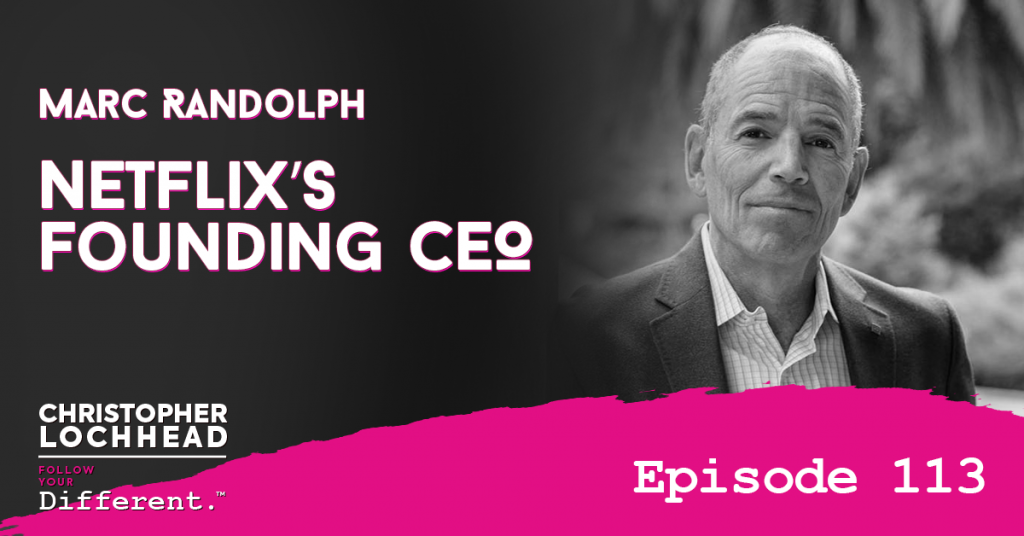
Podcast: Play in new window | Download (Duration: 59:52 — 55.1MB) | Embed
Subscribe: Apple Podcasts | Spotify | Pandora | RSS | More
Category King Marc Randolph, the founding CEO of Netflix, joins us today for a stunning conversation about business and life. He’s got a legendary bestseller out called That Will NEVER Work: The Birth of Netflix and the Amazing Life of an Idea, which he also talks about in this episode.
This is the first in a special two-part series about two of the most legendary category king companies in the world now Netflix and Amazon. Next episode is with John Rossman, author of “Think Like Amazon.”
Book: That Will Never Work
After nearly 16 years after he left Netflix, Marc Randolph talks about his book That Will Never Work. He candidly shares that all those years waiting for the right time to write a book helped him to gain perspective.
First, he says he is wiser business-wise as he worked with a lot of startup companies in the past 16 years. He says he can now identify patterns as they emerge and can safely say he can tell between what works and will not.
“The other cool thing that came out of waiting was, being able to look back and be honest about myself. To really say, ‘I don’t care how it’s perceived. I want this to be a real true portrayal of what it’s like in a startup.’” – Marc Randolph
Remembering Moments, Not Details
Marc also shares that he tried to get it right, but since he is writing about events that took place around 20 years ago, he shares how ridiculous it would be to remember every line and dialogue that he featured in the book.
He also shares he focused on remembering the moments, especially the mood of the conversations that he had. Christopher even remarked a portion of the book where Marc wrote: “This is a memoir, not a documentary. This is kind of how I remember things. I’m not trying to get it 100% right.”
Everything is Intermingled
Christopher chides with Marc on the part where he mentions that personal life intermingles with business life. Marc stressed the importance of devoting time for spouses and kids, as this is a realistic portrayal of a startup.
“I think part of being successful is having balance in your life. I preach about culture is not about what you say, it’s what you do. So I wanted to show how we did it, how do you really have balance in your life.” – Marc Randolph
To hear more about life and business lessons from Netflix Founding CEO Marc Randolph, download and listen to the episode.
Bio:
Marc Randolph is a veteran Silicon Valley entrepreneur, advisor, and investor. As co-founder and founding CEO of Netflix, he laid much of the groundwork for a service that’s grown to 150 million subscribers and fundamentally altered how the world experiences media.
He also served on the Netflix board of directors until retiring from the company in 2003.
Marc’s career as an entrepreneur spans four decades.
He’s founded or co-founded six other successful startups, mentored hundreds of early-stage entrepreneurs, and as an investor has helped seed dozens of successful tech ventures (and just as many unsuccessful ones).
Most recently, he co-founded analytics software company Looker Data Sciences, which was recently purchased by Google for $2.6 billion.
Outside of the tech and startup world, Marc sits on the boards of Chubbies Shorts, Augment Technologies, the environmental advocacy group 1% For The Planet, and the National Outdoor Leadership School (NOLS), which he’s been involved with for most of his life.
A resident of Santa Cruz, California, Marc travels and speaks all over the world, and still probably manages to go surfing more than you do.
Links:
We hope you enjoyed this episode of Follow Your Different™! Christopher loves hearing from his listeners. Feel free to email him, connect on Facebook, Twitter, Instagram and subscribe on iTunes! Get amazing, different stories on business, marketing, and life. Subscribe to our newsletter The Difference.
112 California Wildfires & The Heroes Who Fight Them w/ TJ Welch
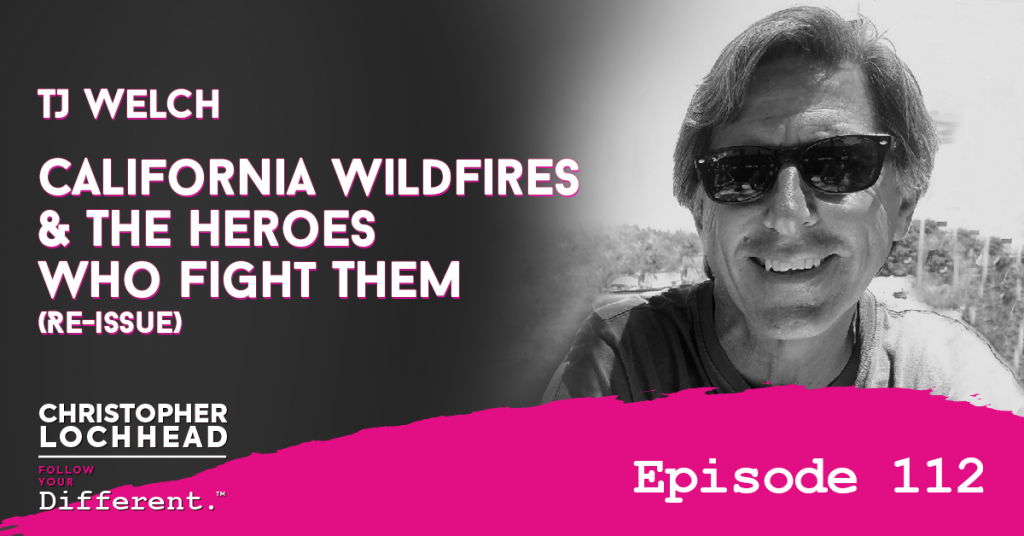
Podcast: Play in new window | Download (Duration: 1:04:17 — 59.2MB) | Embed
Subscribe: Apple Podcasts | Spotify | Pandora | RSS | More
As California is suffering another horrible season of wildfires, we thought it would be powerful to give you some inspiring insight into how heroes fight these massive fires. On this special reissue episode, Retired Battalion Chief TJ Welch gives us an insider’s view of how thousands of Firefighters and first responders spring into action in a matter of hours to save lives and property.
TJ Welch – Starting Out in the City
TJ spent the first years of his career dealing with brush fires and structural fires. He also had his fair share of wildland fires as a chief officer. But he and other city firefighters pretty much only stood guard in front of the houses.
It wasn’t until the late ‘90s when they made full use of city firefighters. They went to timber and brush areas to stop fires and perform other operations.
“This was my moment where it kind of changed my perspective of my role as a chief officer.” – TJ Welch
Wildland Fire in Numbers
Back in the day, the biggest of wildland fires reached up to 160 thousand acres, which is equal to the same number of football fields. This number has been expanding in recent years, reaching up to 200 thousand acres of wildland catching fire.
The terrifying numbers make sense when taken in the context of the number of residences, the timber that is involved, how exposed the wood is, and how quickly it burns. These wildland fires burn a couple of football fields per second. They are impossible to outrun and risk many lives.
There’s a lot of reasons as to why wildland fires catch so quickly. On the other hand, timber could take a while to dry and get moisture back. With the drought that has gone on for so many years along with other forest products left out in the open, the wildland fires have become more gigantic.
A Turning Point
There was one fire that forever changed TJ. This gave way to a collective effort to train firefighters in the art of effective mobilization when tempering these massive fires.
“When I left that fire, I said I’m not gonna be so ignorant when I come to another wildland fire.” – TJ Welch
To hear more about how California firefighters move as a unit and how TJ Welch dealt with the massive responsibility of being a leader, download and listen to the episode.
Bio:
TJ Welch is a 32 year veteran of the fire service.
Throughout the course of his career, he served in volunteer, industrial and municipal fire departments.
TJ was a member of CAL Fire ICT 3 from 1997-2005 and a founding member of CICCS. He was a qualified Type OSC2, OPBD, DIVS, and STEN.
TJ retired in 2014 as Battalion Chief with Alameda County Fire Department.
He currently teaches and writes Officer courses for OSFM, and is a Firefighter Safety Specialist for California Department of Public Health and NIOSH where he investigates firefighter line of duty deaths.
Links:
How to donate to victims of Fires in California:
How To Help Victims Of California Wildfires As Tens Of Thousands Are Forced To Flee Homes
Supplying Aid To Victims Of Emergency (Save)
California Community Foundation: Wildfire Relief Fund
We hope you enjoyed this episode of Follow Your Different™! Christopher loves hearing from his listeners. Feel free to email him, connect on Facebook, Twitter, Instagram and subscribe on iTunes! Get amazing, different stories on business, marketing, and life. Subscribe to our newsletter The Difference.
022 Is Your Marketing Better or Different?
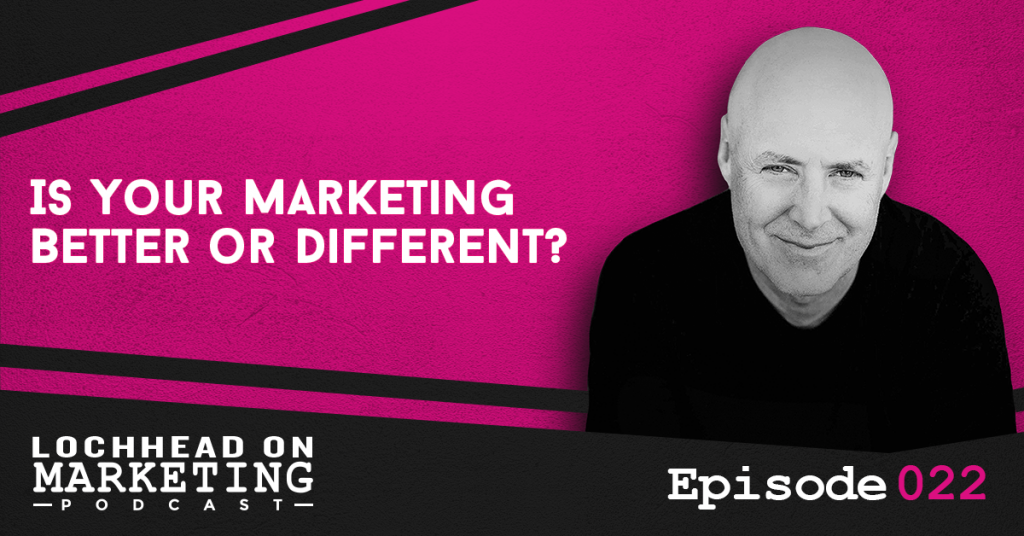
Podcast (lochheadonmarketing): Play in new window | Download (Duration: 7:41 — 7.2MB) | Embed
Subscribe: Apple Podcasts | Spotify | RSS | More
Christopher Lochhead discusses differentiation or differentiators of a brand, product or company. He further shares what legendary marketers do, makes their marketing better or makes it different?Differentiators
We often hear this word a lot in marketing: differentiation. Christopher poses the question when speaking about a product or brand differentiation, is it really different or is it better? In reality, when most CEOs, CMOs, entrepreneurs and product investors say differentiators, what really comes out of their mouth is better. Christopher however, believes making a difference is the better choice.True Differentiation
Christopher suggests a brainstorming session with people in order to determine true differentiation. Create a list of “what makes you different.” Step back and look at your extensive list and tick what makes you different.“If you have a list of 50 differentiators out there, if five of them are truly different, you’ll be doing well, I think.” – Christopher LochheadWhy does this matter? It matters because different forces a choice, and better is a comparison game. Legendary marketers want to own a position where they can’t be easily knocked off. They prefer the perception of being unique, distinct, hard to replace and as someone who solves a problem and creates value.
The “Better” Game
Christopher cites Pepsi as the top contender in this “better” game. They run a series of campaigns comparing themselves to Coke. However, this still proves to be ineffective.“The problem with this better game is, whatever you’re comparing yourself better with, ultimately, is the thing you’re giving power to.” – Christopher LochheadOne of the legendary things that category designers and creators tend to do is to never talk about competitors. Exactly, for this reason, the different conversation, forces a choice. Fundamentally, marketing is about distinguishing oneself.

